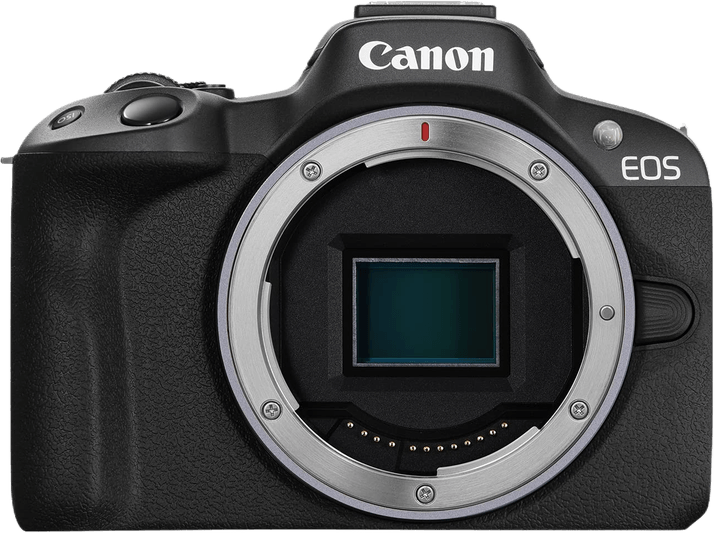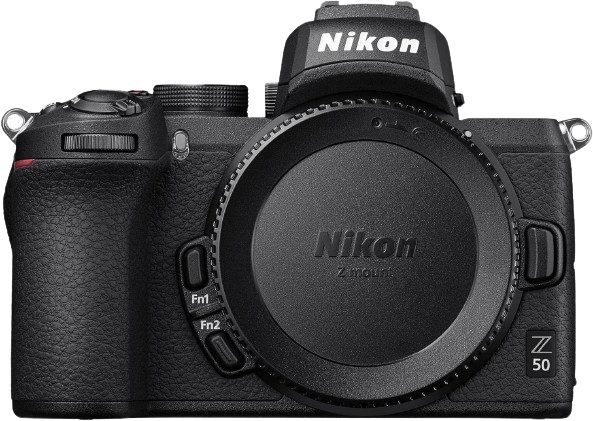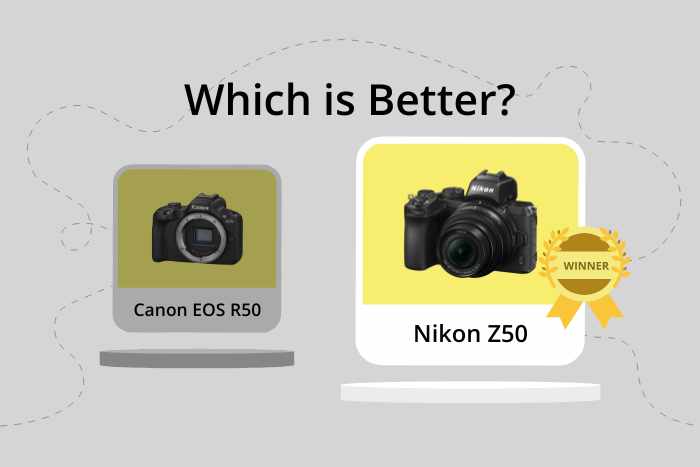Canon EOS R50 vs Nikon Z50 Comparison
Canon EOS R50

Nikon Z50

The Nikon Z50 emerges as the winner with a score of 73/100, while the Canon EOS R50 trails slightly behind with a score of 70/100. Both cameras share similarities as mirrorless models released in 2019 and 2023, respectively. They also have comparable launch prices, with the Canon EOS R50 at $679 and the Nikon Z50 at $859.
The Canon EOS R50 boasts a lighter weight of 375g (0.83lbs) and a more compact size, measuring 116 x 86 x 69mm. This makes it more portable and easier to handle. On the other hand, the Nikon Z50, weighing 450g (0.99lbs) and measuring 127 x 94 x 60mm, outperforms the Canon EOS R50 with its higher score, making it a better camera despite its larger size and weight.
Taking these factors into account, the Nikon Z50’s superior performance justifies its higher price and larger build. Meanwhile, the Canon EOS R50 offers a more budget-friendly option with its lower price and smaller size, making it suitable for users who prioritize portability.
Canon EOS R50 vs Nikon Z50 Overview and Optics
The Canon EOS R50 narrowly edges out the Nikon Z50 in optics with a score of 73/100 compared to the Nikon Z50’s 72/100. Both cameras share several specifications, such as a CMOS sensor type, an APS-C sensor size, and the lack of image stabilization. Additionally, both cameras have their respective lens mounts – the Canon RF and the Nikon Z.
The Canon EOS R50 has a few advantages over the Nikon Z50. It offers a higher megapixel count of 24 compared to the Nikon Z50’s 21, allowing for more detailed images. The Canon EOS R50 also has a faster shooting speed of 12 frames per second, compared to the Nikon Z50’s 11 frames per second, which can be beneficial for capturing fast-moving subjects. The R50 features a Digic X processor, contributing to faster processing times and better overall performance.
On the other hand, the Nikon Z50 has a higher DXOMARK score for its sensor at 97, compared to the Canon EOS R50’s 94. This suggests that the Nikon Z50’s sensor may provide better image quality and low-light performance. However, this advantage is not enough to surpass the Canon EOS R50’s overall optics score.
Taking into consideration the optics scores, shared specifications, and individual advantages, the Canon EOS R50 proves to be the better camera in terms of optics. The higher megapixel count and faster shooting speed provide the edge needed for the Canon EOS R50 to outperform the Nikon Z50. While the Nikon Z50’s sensor may have a higher DXOMARK score, the Canon EOS R50’s overall performance in optics makes it the ideal choice for photographers seeking superior image quality.
Canon EOS R50 vs Nikon Z50 Video Performance
The Canon EOS R50 and Nikon Z50 both excel in video capabilities, earning identical video scores of 91/100. These cameras share several key specs, making them strong contenders for videographers. Both offer 4K max video resolution with dimensions of 3840 x 2160 and a max video frame rate of 120fps. Additionally, they each have built-in time-lapse functionality, further enhancing their video capabilities.
The Canon EOS R50 stands out with its user-friendly interface and reliable autofocus system. These features allow for smoother video recording and enhanced ease of use, particularly for those new to videography. The R50’s image stabilization system also ensures steadier footage, making it an ideal choice for shooting in various conditions.
On the other hand, the Nikon Z50 offers advantages in terms of color reproduction and dynamic range. This camera captures vibrant, true-to-life colors and retains more detail in shadows and highlights, resulting in visually appealing footage. The Z50’s compact and lightweight design makes it a suitable option for on-the-go videographers and travelers.
Both cameras excel in video capabilities, but the Canon EOS R50’s user-friendly interface and reliable autofocus system make it a more accessible choice for beginners. Meanwhile, the Nikon Z50’s superior color reproduction and dynamic range may appeal to more experienced videographers seeking visually stunning footage. Ultimately, the choice between these two cameras depends on the user’s preferences and specific video requirements.
Canon EOS R50 vs Nikon Z50 Features and Benefits
The Nikon Z50 emerges as the winner with a feature score of 86/100, while the Canon EOS R50 trails at 72/100. Both cameras share several similar specifications, making them strong contenders in the market. Their shared features include a touchscreen, flip screen, GPS, WiFi, and Bluetooth connectivity.
The Nikon Z50 outperforms the Canon EOS R50 in terms of screen size and resolution. The Z50 has a 3.2-inch screen, which is larger than the EOS R50’s 3-inch screen. Despite having a lower resolution of 1,040,000 dots compared to the EOS R50’s 1,620,000 dots, the larger screen size provides a more comfortable and enjoyable user experience for photographers.
On the other hand, the Canon EOS R50’s higher screen resolution offers a sharper and more detailed image preview, which can be advantageous for photographers who prioritize image quality and accuracy. However, this advantage is not enough to offset the benefits of the Nikon Z50’s larger screen.
After comparing the features of both cameras, it is clear that the Nikon Z50’s larger screen size gives it an edge over the Canon EOS R50. The Canon EOS R50’s higher screen resolution provides a minor advantage, but it does not outweigh the benefits of the Z50’s more extensive display. Therefore, the Nikon Z50 is the better camera in terms of features, as evidenced by its higher score.
Canon EOS R50 vs Nikon Z50 Storage and Battery
The Canon EOS R50 and Nikon Z50 have an equal storage and battery score of 35/100. Both cameras share some common specifications, such as having one memory card slot and the ability to charge via USB. They accept SD, SDHC, and SDXC memory cards, with the Canon R50 being compatible with both UHS-I and II, while the Nikon Z50 is only compatible with UHS-I.
The Canon R50 holds a slight advantage in battery life, offering 370 shots compared to the Nikon Z50’s 320 shots. However, the Nikon Z50 has its own merit in using the EN-EL25 battery type, which may be preferred by some users who already own compatible Nikon accessories.
Taking these factors into account, the Canon R50’s longer battery life and broader memory card compatibility give it a slight edge in the storage and battery department. The Nikon Z50, on the other hand, may be more suitable for those who prioritize brand-specific battery compatibility. Ultimately, both cameras offer adequate storage and battery performance for their class.
Canon EOS R50 vs Nikon Z50 Alternatives
Are you considering buying or upgrading from a Canon R50 or a Nikon Z50? Our camera comparison tool can help you weigh up its price and performance against the competition.
Here are some related popular camera comparisons to check for inspiration:

